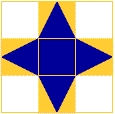I've been using my own technique - The Lorraine Lowe technique - for trimming applique and stitchery blocks for years now. It probably goes back to my first time using Lori Smith's quilt patterns as they often end up at odd sizes such as 7 7/8 inch finished blocks.
What do you do when nobody makes a square ruler in the right size?
For this tutorial I will show how I trimmed down oversized applique blocks (There always appears to be a bit of shrinkage in background fabric during the applique or stitchery. It is wise to start with a bigger piece of background fabric, then trim the block after stitching).
My blocks are from a Lori Smith pattern, with a 13 3/4 inch finished block. This means I need to cut them 1/4 bigger along each edge.
First I have some template plastic with a quarter inch grid on it. I usually like to buy one big piece, then cut it to the finished size of the block, but I am living in a smallish quilting community and this is what I could get.
First I used paper scissors to trim away the clear edges without grid, and sticky taped the pieces together.
Be careful. Sometimes the grid won't line up exactly. It seems to be square in one direction, but not the other
I had to measure with the laser cut yellow ruler, then trim away about 1/8 inch along one edge of the plastic. Now it is square, and it is the finished size of my applique block after piecing in the quilt.
Next I write the size on the plastic with a permanent texta.
Then I mark the centre of the plastic with a permanent texta.
Keep your sticky tape handy. Press the back of the applique block then place it on your cutting mat with the design facing up.
Position the template plastic square using your centre marking AND ALSO looking at how much applique is near each edge. Try to ensure there is a pleasing amount of space around the applique. This is why the grid plastic is helpful.
Sometimes you need to make a choice when placing your template plastic. The design may be too close to the edge, and you need to choose what to cut off and what to go around. Whatever is covered by the plastic is what will show up in your finished block.
In this block I chose to cut off the bottom of the trees rather than to cut the birds wings.
The template plastic square may need to be placed slightly diagonal, which makes the edges off-grain, and more likely to stretch (be careful!). I choose to keep them as square as possible, but with this particular quilt I was adding sashing, so the block should stay pretty square if I pin each edge very precisely.
When you are happy with the placement, use sticky tape to hold the template plastic onto your applique block.
With your ruler, line up the grid with the ruler lines, allowing the ruler to overhang the template plastic by 1/4 inch. There should be no possible way your rotary cutter can cut the plastic. The cut will be made 1/4 inch away from the template plastic. Cut one side with the rotary cutter.
Try to leave the block on the cutting mat without picking it up to turn it (I like to cut mine on an island bench). If you do need to lift the block to turn it to cut the next side, lift it gently while supporting the plastic and block together. Cut each side 1/4 inch away from the template plastic using the ruler to measure.
Lift the template plastic square off the block. The sticky tape will stay attached to the plastic.
Press another block, position the template plastic where it is pleasing, and trim each edge, adding 1/4 inch on each side.
I usually trim my blocks down when I am just about to stitch them into a quilt, so that the freshly cut edges are not handled a lot, and are less likely to stretch if they are slightly off grain.
In this block it was more important to have the petals of the flower an equal distance from the edges of the block, than to have the centre in the exact middle (it may be 1/4 inch skewed, but it is still pleasing to the eye).
In this symmetrical block, lining up the centre vertically was very important or it will look like the flower is leaning to one side.
Thank you for reading my tutorial using the Lorraine Lowe technique for trimming applique blocks accurately.
Please feel free to share the entire post without editing or sampling.
Subscribe to:
Post Comments (Atom)











































 Quilter Blogs & Store Search
Quilter Blogs & Store Search


No comments:
Post a Comment